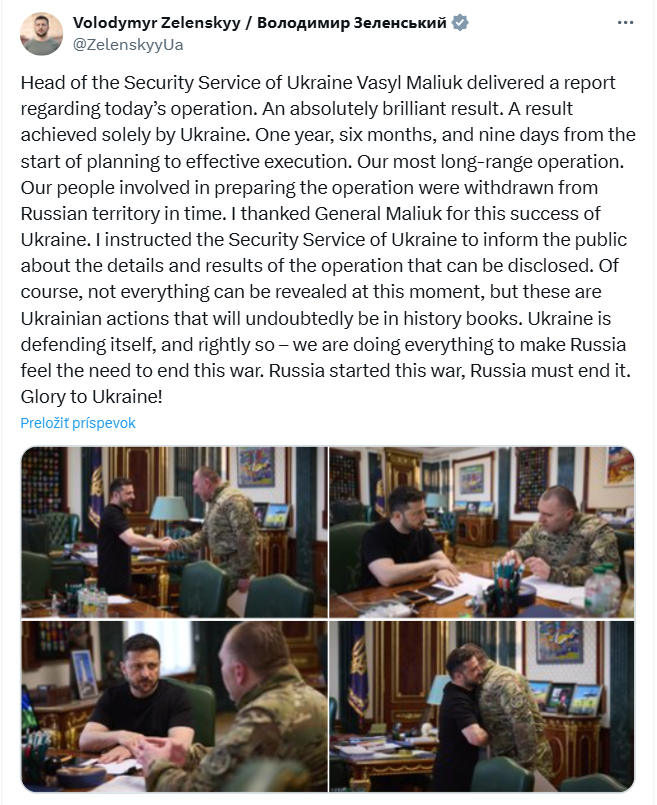As you read this fallen soldiers are returning to Ukraine as a huge exchange negotiated in Istanbul, Turkey develops. More than 1200 days into the war, over 1200 bodies of soldiers were already returned at the time of writing. It marks one of the biggest war victim returns of the war. Meanwhile, in the city of Sumy, the Ukrainian forces are pushing back the Russian forces, opening a new front in the northeastern part of the country.
“Unfortunately, we do not have enough air defense systems to tightly protect all our cities from Russian strikes. In this regard, Russia is better protected, but the war has exhausted these resources. High losses of air defense systems have exposed many regions of Russia and our attack drones have become more effective in penetrating Russian airspace,” said Alexander Kovalenko, a Ukrainian military expert for PulseZ.
What are the most prominent operations of the recent weeks? And what strategic, military and diplomatic partners are currently the most crucial for Ukraine?
The Ukrainian Trojan Horse
By now, you have probably heard of Operation Spider Web. The complex operation, approved by president Zelensky already 18 months ago has been new in multiple ways. In a sort of “Trojan-horse” type of attack, inconspicuous truck drivers carried in over 100 Ukrainian drones deep into Russian territory, targeting strategic long-range bomber planes. The operation reached places as far as 4000 kilometers from the Ukrainian border.
How did they get inside without anyone knowing? The trucks’ roofs had a top layer that was remotely opened once it reached a strategic destination and released the drones – one of them is visible on the video here. The drivers were Russian, some of them receiving directions over the phone, not knowing the true nature of the operation they were a part of. They were allegedly hired by a mysterious Artem, to deliver wood supplies. The attacking drones were also controlled remotely, most likely through a satellite or the internet, as reported by BBC.
“I think that it is the use of artificial intelligence, in particular, during Operation Spider Web. This allowed maintaining control over drones located not just hundreds, but thousands of kilometers from the operator. Artificial intelligence is already changing approaches to classical conventional warfare,” said Kovalenko.
The potential of the front turning fully into a drone warzone is circulating in the predictions. It replaces the need to send troops into the front lines, and provides new opportunities for intelligence and sound surveillance. First person view (FPV) drones are widely adopted due to their flexibility with replacing parts based on the aim of the mission – from intelligence collection to kamikadze drones. FPV drones allow the operator to see the route in goggles in real-time, allowing for more precise control. Currently, implementation of AI is being used to test target recognition, locking on targets and autonomous navigation.

First person view drone, source: FreePik
Measuring the Impact of Operation Spider Web
“[Operation Spider Web] was a significant one, and I’m not going to talk about the impact on the way other militaries would fight, or how the malign actors may use these ideas against other countries. The reason why we conducted it, is that we didn’t and we still don’t have proper capabilities like long-range missiles. So we find a way to apply a symmetric approach to Russia.
“So we showed that we’re smaller, we don’t have proper capabilities, but we are capable of reaching the sacred nuclear deterrent tools of Russia,” said Alexander Khara, the director of the Center for Defense Strategies, previously a diplomat with the Ukrainian Foreign Ministry, and a member of the National Security and Defense Council for PulseZ.
The destroyed planes were used for surveilling and choosing targets, namely in Ukrainian cities. Further, this operation had a psychological effect in the way it humiliated Putin, at home, abroad and also among his allies such as the Chinese president Xi Jinping or North Korean president Kim Jong-un.
According to Ukraine’s estimates, 41 bombers were hit and 13 destroyed, possibly more. Among the planes were surveillance planes (A-50), bombers (Tu-160, Tu-22) and cruise missiles-launchers (Tu-95). The estimation of damage in similar operations are difficult to confirm and often both sides report very different statistics.
“In most cases, verified information is used – photos or videos. Based on them, one can draw conclusions about both the destroyed equipment and objects, and the extent of damage. But not all data is always posted in the public domain, and journalists do not have access to certain data,” said Kovalenko.

Screenshot of a post on X by president Zelensky. Source: https://x.com/ZelenskyyUa/status/1929238023843012615
Kerch Bridge on Fire, Again
“Ukraine has carried out a number of successful special operations, both on Russian territory and in the temporarily occupied territories. Perhaps the first of these was the operation to blow up the Kerch Bridge. This was the first, high-profile example of Ukraine having every opportunity to conduct high-class operations. Then there were operations to eliminate Russian generals, strikes on military facilities, and so on,” said Kovalenko.
The first major explosions of the Kerch Bridge happened in 2022, then followed in 2023. The bridge, built by Russia after the annexation of Crimea is a hated symbol and a critical infrastructure point. Now, just at the beginning of June, another successful operation led to a closure of the bridge due to underwater explosions.
“One of the factors of success, in addition to many, in particular, the deep elaboration of each action, is the fact that we are well aware of the structure of the Russian security system. They have not evolved or changed in these matters for decades. By predicting their actions in a given situation, we act proactively.
“In addition, in Russia, air defense systems can be equipped not according to the principle of security, but according to the principle of political whims. This is what happened on May 9 [the celebrations of WWII end in Russia,] in Moscow, which was reinforced by transferring air defense systems from other Russian regions, completely stripping them bare, for the sake of the parade’s and Putin’s safety,” said Kovalenko.
The Current State of Ukraine’s Partnerships
The perception of Russia’s war in Ukraine and security threats for Europe are changing, and significantly increasing. At a speech at Chatham House in London, Secretary General of NATO, Mark Rutte said that Russia can be ready to attack in 5 years and he considers Russia a threat to the entire continent. The support of Ukraine is in many ways perceived as keeping the nuclear superpower out of Europe since the start of the war.
“We have more than 50 countries that provide us with defense assistance and more countries that are providing us with economic or humanitarian assistance, which is pretty good.
“Unfortunately, at the moment, we see that the United States just stepped back from this support, and Mr. Trump and his administration constantly have been talking about peace efforts and acting from a position of strength, but in reality, they’ve been downgrading their political, diplomatic, and military support from Ukraine,” said Khara.
Khara also speaks about the revisionist ideology of Russia, looking back at the collapse of the Soviet Union as a tragedy and thus exercising efforts to destabilize the previously Soviet region, including Moldova or Georgia. Hybrid threats and information warfare are a part of the strategies as much as physical warfare.
“They want to take control of the Baltic republics. They want to undermine the security of Poland. And certainly they were aggressive in the Black Sea, and fortunately we were able to decimate their Black Sea fleet,” said Khara.
The Shift Towards Diplomatic Efforts
The diplomatic approach to Russia’s war on Ukraine spilled over to Europe after the inauguration of Trump and his start of having conversations with Putin. However, from the very start, Trump was friendly with Putin, taking his businessman approach and fostering a personal relationship with Putin, amplifying the propaganda of Kremlin, for example that Ukraine has no “cards” to play with and peace under Putin’s term is the only option.
“When we’re talking about the diplomatic support, I understand why the Ukrainian government and our European partners changed their rhetoric back in January after the inauguration of Mr. Trump, and they shifted from supporting Ukraine to beat Russia on the battlefield to the sort of diplomatic solution. And we in Ukraine are skeptical. I understand that we needed to talk about a diplomatic solution to keep Americans in diplomatic effort in providing assistance and so on and so forth. But in reality, it’s absolutely clear that Putin is not going to stop.
“This war is about the Russian dream to establish itself as a geopolitical actor and have better positions in Europe. Back in 2021, before the, well, for the first time after 2014, they demanded from the United States and European part of NATO that the United States would retreat from the continent and NATO would expel Central and Eastern European countries from this organization,” said Khara.
Strategy Towards the EU accession
Ukraine was not always ready to be a member of the EU or NATO. Only after the start of the war, people in Ukraine realized that NATO can secure their safety from Russia for the future.
“The previous president Petro Poroshenko voted into the constitution that Ukraine’s strategic goal was to become a member of NATO and the European Union. And then it was Zelensky, after the full-scale invasion [in 2022], who applied for membership in NATO.
“Fortunately Europeans finally made up their minds that Ukraine should be and will be a member of NATO in some future. Some people are talking about 2030, that’s a realistic term for Ukraine to be ready to join the Union,” said Khara.
However, there are outliers, such as Hungary or Slovakia, questioning sanctions on the grounds of gas and oil prices. The EU is stepping up in these cases, thinking of ways to bypass vetoes on sanctions against Russia and blocking help for Ukraine which we covered previously.
What Happens Next?
At the beginning of June, the European Commission proposed to extend the temporary protection of Ukrainian refugees of war in Europe until the beginning of March 2027. More than 4.3 million people have already fled the country as a result of the ongoing war.
Ukraine and Moldova will be joining the EU mobile roaming zone on January 1, 2026. This will mean the same conditions for call, message and data rates as when EU citizens travel between other member states.
Meanwhile, the successful Spider Web made even Russian Telegram users agree that this was a massive failure on the Russian part. However, it poses serious concerns about Putin’s retaliation. Retaliation would mean admitting that the attack was significant by Putin. The reporting in Russian media when days after Putin had a call with Trump, was focusing on peace talks in Istanbul, ignoring the topic of Spider Web.
The memorandum presented at the Istanbul peace negotiations does not present a sustainable peace option as it requires Ukraine to give up territories that Russia claims to be theirs.
“Unless we defeat Russia, none of the support that’s been provided to us is enough. And certainly, we are losing the most precious thing, our people,” concluded Khara.
